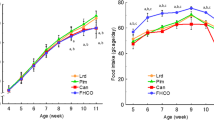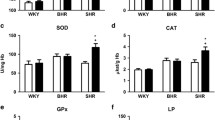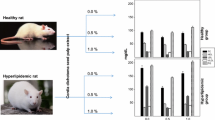Abstract
The effects of long-term dietary application of garlic (dried powder, 0.5% in weight of standard chow; G group) or linseed oil (2.5%; L group) as well as a combination of both interventions (L+G group) on the life span of hypertensive rats (SHR SP) was investigated. A further group fed with standard chow served as control (C). The dietary interventions were started at the age of three weeks. Besides regular measurements of the systolic arterial blood pressure (oscillometrically at the tail artery) as well as of heart rate and body weight, autopsy and histological investigations were performed.
Both diets, and particularly their combination, prolonged life span significantly (mean values (days) C: 434.5±23.5; G: 453.2±16.2; L: 470.0±26.2; L+G: 494.8±39.2).
There was no significant interaction of the factors garlic and linseed oil. Systolic blood pressure as measured during the compensatory stage (data used until the 39th week of life) was significantly lowered by both garlic (mean −5.8 mm Hg), linseed oil (mean −6.3 mm Hg), and their combination (mean −11.3 mm Hg).
The animals died as a consequence of congestive left and right ventricular failure with ventricular hypertrophy, dilatation, myocardial fibrosis and cellular infiltration, left ventricular atrial thrombosis (in most cases), and terminal pneumonia. On the other hand, arteriosclerotic plaques and signs of cerebral stroke could not be detected. Except for the degree of hypertrophy, which was lower in the treated groups, no differences were obvious regarding the morphological findings at the time of death. There was a significant positive correlation between mean blood pressure and the degree of left ventricular hypertrophy. Furthermore, a significant negative correlation between mean blood pressure and ventricular hypertrophy on the one hand and survival on the other hand was obvious provided the total number of animals was considered, however, not aithin the individual groups. The same applies to the relation between the reduction of left ventricular hypertrophy and life span.
The relatively slight hypotensive effect of both dietary interventions as well as the results of previous investigations speaks in favor of a substantial influence of factors independent of blood pressure. In view of controversial results and interpretations in international literature, the mechanisms involved need further study.
Similar content being viewed by others
References
Adam O (1985) Ernährungsphysiologische Untersuchungen mit Formeldiäten: Der Stoffwechsel mehrfach ungesättigter Fettsäuren und die Prostaglandin-biosynthese beim Menschen. Klin Wochenschr 63: 731–739
AlMakdessi S, Sweidan H, Jacob R (1994) N-3 versus n-6 fatty acid incorporation into the phospholipids of rat heart sarcolemma. A comparative study of four different oil diets. J Mol Cell Cardiol 26: 23–29
Benz M, Steinhilber D, Jacob R (1993) The effects of various dietary supplementations on the formation of 5-lipoxygenase products in rat peritoneal neutrophil granulocytes. Pflüg Arch 422 (suppl 1): R116
Bordet J-C, Guichardant M, Lagarde M (1986) Arachidonic acid strongly stimulates prostaglandin I3 (PGI3) production from eicosapentaenoic acid in human endothelial cells. Biochem Biophys Res Commun 135: 403–410
Brändle M, Jacob R (1990) Effects of a diet rich in-3 fatty acids on left ventricular geometry and dynamics in spontaneously hypertensive rats. Europ J Appl Physiol 61: 177–181
Brosche T, Siegers C-P, Platt D (1991) Auswirkungen einer Knoblauch-Therapie auf die Cholesterin-Biosynthese sowie auf Plasma- und Membranlipids. Med Welt 7a: 10–11
Codde JP, Croft KD, Vandongen R, Beilin LJ (1987) Effects of fish oil “Max EPA” on blood pressures and prostanoid metabolism of spontaneously hypertensive rate during salt loading. Adv Prostaglandin Thromboxane Leukotriene Res 17: 729–732
Dierberger B, Schäch M, Anadere J, Brändle M, Jacob R (1992) Effect of a diet rich in linseed oil on complex viscosity and blood pressure in spontaneously hypertensive rats. Basic Res Cardiol 86: 561–566
Ehrsam MJ (1992) Effekte einer chronischen Knoblauchdiät auf Struktur und Funktion des Herzens bei spontanhypertensiven Ratten (SHR). Inauguraldissertation Tübingen
Eickhorn R, Isensee H, Jacob R, Antoni H (1992) No obvious influence of dietary fatty acid intake on cardiac sodium current of the heart. Pflüg Arch 402: 334
Ernst E (1987) Cardiovascular effects of garlic (Allium sativum): a review. Pharmatherapeutica 5: 83–89
Hwang DH, Caroll AE (1980) Decreased formation of prostaglandins derived from arachidonic acid by dietary linolenate in rats. Am J Clin Nutr 33: 590–597
Ikeda K, Nara Y, Yamori Y (1991) Chloride ion ingested with sodium affects the development of cerebral lesions in stroke-prone spontaneously hypertensive rats. Clin Exp Pharmacol Physiol 18: 393–396
Isensee H (1992) Kardioprotektive Effekte verschiedener Diätformen — Auswirkungen von mehrfach ungesättigten Fettsäuren und Knoblauch auf Arrhythmieneigung und Infarktgröße bei Ischämie und Reperfusion. Inauguraldissertation Tübingen
Isensee H, Jacob R (1994) Differential effects of various diets on risk of cardiac arrhythmias. J Cardiovasc Risk 1: 353–359
Isensee H, Rietz B, Jacob R (1993) Cardio protective actions of garlic. Arzneim Forsch/Drug Res 43: 94–98
Jacob R, Brändle M, Dierberger B, Ohkubo T, Rupp H (1991) Antihypertensive und Kardioprotektive Effekte verschiedener Öldiäten. In: Ganten D, Mall G. (eds) Herz-Kreislauf-Regulation, Organprotektion und Organschäden. Schattauer Verlagsgesellschaft, Stuttgart, pp 25–46
Jacob R, Ehrsam M, Ohkubo T, Rupp H (1990) Antihypertensive and cardioprotective effects of garlic powder in spontaneously hypertensive rats. Med Welt 7a: 41–43
Jacob R, Isensee H, Rietz B, Makdessi S, Sweidan H (1993) Cardioprotection by dietary interventions in animal experiments. Effect of garlic and various dietary oils under the conditions of experimental infarction. Pharm Pharmacol Lett 3: 131–134
JMP: Statistics and graphics guide. Version 3 of IMP. Statistical software for the Macintosh from SAS Institute Inc
Lefer AM, Ogletree ML, Smith JB, Silver MJ, Nicolan KC, Bernette WE, Gasic GP (1978) Prostacyclin: a potentially valuable agent for preserving myocardial ischemia. Science 200: 115–125
Maakheja AN, Vanderhoek JY, Bailey JM (1979) Inhibition of platelet aggregation and thromboxane synthesis by onion and garlic (Letter). Lancet i: 150–151
Marshall LA, Szcesniewski A, Johnson PV (1983) Dietary α-linolenic acid and prostaglandin synthesis: a time course study. Am J Clin Nutr 38: 895–900
Medugorac I (1980) Collagen content in different areas of normal and hypertrophied rat myocardium. Cardiovasc Res 14: 551–554
Mest HJ, Beitz J, Heinroht I, Block HU, Förster W (1983) The influence of linseed oil diet on fatty acid pattern in phospholipids and thromboxane formation in platelets in man. Klin Wochenschr 61: 187–191
Mest HJ, Förster W (1978) The antiarrhythmic action of prostacyclin (PGI2) on aconitine induced arrhythmias in rats. Acta Biol Med Germ 37: 827–828
Neil A, Silagy Ch (1994) Garlic: its cardio-protective properties. Current Opinion in Lipidology 5: 6–10
Ohkubo T, Rupp H, Jacob R (1991) Effect of linseed oil feeding on blood pressure, vascular prostanoids and fatty acids in SHR. Pflüg Arch 418 (Suppl 1): R107
Okamoto R, Ohta Y, Chikugo T, Shiokawa H, Morita N (1991) Chronic treatment with captopril, SQ29, 852, hydralazine and a 33% fish meal diet in malignant stroke-prone spontaneously hypertensive rats. J Hypertens 9: 1105–1117
Peuler JD, Schelper RL (1992) Partial protection from salt-induced stroke and mortality by high oral calcium in hypertensive rats. Stroke 23: 532–538
Rashid A, Khan HH (1985) The mechanism of hypotensive effect of garlic extract. JPMA 35: 357–362
Reuter HD (1991) Allium sativum L. Aesopus Verlag GmbH, Basel
Rietz B, Isensee H, Strobach H, Makdessi S, Jacob R (1993) Cardioprotective actions of wild garlic (Allium ursinum) in ischemia and reperfusion. Mol Cell Biochem 119: 143–150
Ross C, Gülich RW, Jacob R (1994) Cardiac protection from Ca++ overload by diets rich in Ω-3 fatty acids. Pflüg Arch 426 (No6): R119
Scherhag R, Kramer HJ, Düsing R (1982) Dietary administration of eicosapentaenoic and linolenic acid increases arterial blood pressure and supresses vascular prostacyclin synthesis in the rat. Prostaglandins 23: 369–382
Schrör K, Hofefeld Th (1993) Prostyglandins and cytoprotection in myocardial ischemia. Pharm Pharmacol Lett 3 (Suppl): 85–88
Schulz V, Hänsel R (1996) Rationale Phytotherapie. Springer, Berlin, Heidelberg, New York, S 122–136
Shimokawa T, Moriuchi A, Hori T, Saito M et al. (1988) Effect of dietary alphalinolenate/linoleate balance on mean survival time, incidence of stroke and blood pressure of spontaneously hypertensive rats. Life Sci 43: 2067–2075
Siegel G, Emden J, Wenzel K, Mironneau J, Stock G (1992) Potassium channel activation in vascular smooth muscle. In: Franck GB (ed) Excitation-Contraction Coupling in Skeletal, Cardiac and Smooth Muscle. Plenum Press, New York, pp 53–72
Srivastava KC (1991) Theombozyten-aggregationshemmende Bestandteile des Knoblauchs. Med Welt 7a: 45
Stier CT Jr, Mahboubi K, DiPippo VA, Levine S, Chander PN (1992) The antiproteinuric action of enalapril in strokeprone spontaneously hypertensive rats is unrelated to alterations in urinary prostaglandins. J Pharmacol Exp Ther 260: 1410–1415
Szekeres L (1987) Cardioprotection by anti-ischaemic and cytoprotective drugs. In: Jacob R, Just HJ, Holubarsch CH (eds) Cardiac Energetics. Darmstadt: Steinkopff, New-York-Springer, 325–333
Taube C, Hohler H, Lorenz S, Förster W (1984) The role of TxA2 in hypertension. Biomed Biochim Acta 43: S208-S211
Török B, Belagyi J, Rietz B, Jacob R (1994) Effectieveness of garlic on the radical activity in radical generating systems. Arzneim Forsch/Drug Res 44 (I): 608–611
Wagner H, Breu W, Redl K, Sendl A, Steinke B (1991) Wirkung von Allium-Arten auf den Arachidonsäurestoffwechsel und die Thrombozytenaggregation. Med Welt 7a: 37–38
Wagner H, Sendl A (1991) Bärlauch und Knoblauch. Vergleichende chemische und pharmakologische Untersuchungen von Bärlauch- und Knoblauchextrakten. Deutsche Apothekerzeitung 33: 1809–1815
Walper A (1991) Knoblauchzubereitungen in der klinischen Prüfung (Garlic preparations in clinical trials). Österreichische Apothekerzeitung 46: 269–271
Watanabe Y, Huang YS, Simmons VA, Horrobin DF (1989) The effects of dietary n-6 and n-3 polyunsaturated fatty acids on blood pressure and tissue fatty acid composition in spontaneously hypertensive rats. Lipids 24: 638–644
Author information
Authors and Affiliations
Rights and permissions
About this article
Cite this article
Brändle, M., Al Makdessi, S., Weber, R.K. et al. Prolongation of life span in hypertensive rats by dietary interventions. Effects of garlic and linseed oil. Basic Res Cardiol 92, 223–232 (1997). https://doi.org/10.1007/BF00788517
Received:
Revised:
Accepted:
Issue Date:
DOI: https://doi.org/10.1007/BF00788517




